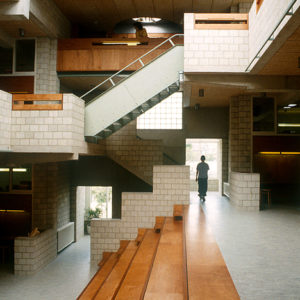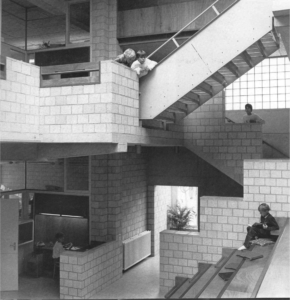Constructing A Better Future: Children’s Space
The universal experience, lived by all humanity, is the learning experience. Although, not all lessons, taught to every individual, is the exact same, the psychological stages that every individual goes through, is. Each learning experience, shapes one’s outlook and perspective of life; and the most critical time of when one’s outlook on life is shaped is when one is growing as a child. All children are raised differently; culture (which includes traditional values), economic status, and location, all play a role with how children are raised, and along with that the development of their moral view of the world. Although many might neglect the fact that children’s built surroundings are impactful to how they can then define themselves and life phenomena, the reality is that without a physical structure, or a built environment, many of the things they know as children, and then take into adolescence and adulthood, wouldn’t be a sure thing. The architecture and set up of the built environments that children are exposed to on a daily, such like playgrounds, and schools, are factors that can be structured in such a way to give children freedom to truly express their feelings and thoughts; these built environments should actually welcome this. Built environments affect how a child develops their moral view of the world; and they provide children instructions that include: responsibility, the knowledge of limits (respect), and “life lessons”, therefore it is also very important to note what and how the specific built environment is presented to children.
Understanding that not all children come from the same cultural background and from the same psychological upbringings is crucial for the types of built environments that adults expose children to and what they expect from them. For example, in the film, “The Land”, there is a unique type of playground presented (adventure playground), and it’s a place that welcomes a diverse body of children, because it’s structure isn’t the typical structure of “what a playground should be like”. Like Marjory Allen (landscape architect and creator of this Adventure playground) suggests, the typical playground given to children isn’t fair. In her words, “what do we give them? A squared playground with a few pieces of mechanic equipment, and there they’re expected to spend their adolescent lives swinging back and forth on a swing, it’s not good enough, it’s a problem that had to be solved” (“The Land”). For the fact that not all children are raised the same way, not all children play the same way. The reality is that at first glance this type of adventure playground may seem inappropriate, for the fact that it’s viewed as “dirty, very risky, and dangerous”, but if children are to be exposed to such an environment at an early age, then they can be well prepared to confront any situation, that may include uncontrollable ones such like natural disasters, where they would have to find ways to accommodate themselves and find ways to overcome barriers built by natural occurrences. Children will then be more mentally prepared as to how to react and what actions to take in order to fulfill their basic needs, through the teachings that can be derived from a built environment of this nature. For example, Ethan, 11, the young boy shown in the film, wanted to play baseball, but the usual bat and baseball weren’t present. He then made it his business and responsibility to create his own “bat”, out of a pole stick and a piece of box carton bound together with nylon cables, and to have the “baseball” be snow. Therefore, a moral view of life that children can derived from a playground like this, would be that in life there’s just times where YOU yourself have to find a way of survival, no matter the situation you’re in; you must find the way to keep yourself with a heartbeat, where that’d be a physical heartbeat, or a mental heartbeat, and this correlates to the playgrounds motto at the playground’s entrance, “Work hard, PLAY HARD”.
One point that is very important and obvious to discuss is the way built environments are presented to children. Architecture is very centered around the aesthetics of built environments. It is focused on the structural design that meets the people’s desires and needs. But as Edith Wharton would suggest in her writing, The Decoration of Houses, “Before beginning to decorate a room it is essential to consider for what purpose the room is to be used” (17) (Edith Wharton Ogden Codman Jr. THE DECORATION OF HOUSES). In other words, before determining the design of the physical built environment, it is vital to first build up the purpose for the design of the built environment, and in this case the purpose of built environments surrounding children, are the children themselves; they are the purpose. “Space always has a threefold nature consisting of physical aspects which can be quantified and explained, mental aspects which imply social significance and a third element involving how individuals occupy spaces. Without the action of these individuals the spaces concerned would hold no meaning for us” (Sánchez Romero, Margarita, et al. Children, Spaces and Identity). In other words, space and built environments aren’t just concrete, they go beyond into abstract areas for the children’s benefit as “space helps them to shape their own identity”. Since children are the purpose for physical design and decoration, how should their built environments then be approached ? Well, since children learn and get a lot of intakes from what they see, design that is appealing to the eye is preferable for children. Study shows that colors that are bright block of the color wheel appeal children way more than pastels or muted blends. “Color affects emotions, and can have a significant effect on developing children”. Therefore for decoration of schools, daycare centers, or even playgrounds, colors which children are attracted to, should definitely be taken into consideration. Not only do colors catch the eyes’ attention, but lighting does too. In Gallaudet University, a group of teens felt as if their built environment wasn’t as appealing to the eye, and they felt as if some parts of the University lacked what Wharton would call, “purpose”. So what they did is that one night they gathered at campus, and brought with gel and flashlights to give color to many different parts of the University. The results were phenomenal. There was new meaning given to this campus, just through the use of light. They found “LIGHT as a Way-finder, LIGHT as Identity …” (“Light Up Gallaudet | Benjamin Bahan | TEDxGallaudet.” Deaftube). This was very impactful to groups of teens, now I can imagine the impact it will make unto children. Hence, the aesthetics and purpose of design of is a very important aspect to take into consideration with children’s built environment.
Someone once said, “Architecture is educational”. The physical structure of children’s surrounding influences how they can view the concept of responsibility, alike the freedom they get in “The Land”. With the concept of responsibility comes the power of making your own decisions, and in the dutch schools presented by Herman Hertzberger, children take the decisions of how the architectural layout of their classrooms and playgrounds should be. Hertzberger presents “Images of children playing and learning on broad wooden steps as a creative space” (Cregan, Kate. “Key Projects by Herman Hertzberger.”). Classroom in these schools usually have no doors, and the “study” areas of these children are anywhere; from the hallways, to the wooden steps, and classrooms, but ultimately it is the children that choose. This is very beneficial in developing their moral view of the world, because they not only feel more free and at ease to be themselves, but their way of thinking towards responsibility is more sharpened.


(Dutch school by Hertzberger)
In my experience, I had an impactful interaction, with a built environment (as this interaction taught me a valuable “life lesson”), when casually playing at the playground one day. Since very young, I’ve always been a very active girl. I loved sports and being involved in physical activities at the park. I would beg my mother to stay a “little longer” (which that would always end up in us staying until very late, after dusk) at the playground. What I loved the most was not the swings, and definitely not playing tag, but it was the famous red monkey bars. I loved them because, through imagination, I had great adventures; I had to get to the other side or else something would “come and get me”. I would do flips on the monkey bars, and even stand on them. However, one day my hands were already “reaching their limit”, from being on the monkey bars for so long, and my mom warned me to stop because I was going to hurt myself. But of course, I didn’t listen and bam! I got extremely hurt, peeled my skin off, and started bleeding. The lesson I learned with this “built” environment was that, although sometimes (even majority of the time), one must experience in order to learn from situations, in certain occasions, if one has the strength to resist “temptation” or to “try it out”, one can save themselves from getting really hurt! If I had listened to my mother I would’ve never gotten hurt. Therefore, ironically enough through experience, I learned that sometimes experience isn’t needed to learn certain things, because some things just aren’t worth going through pain for. As a result, a part of my moral view of the world is this: If something is already feeling risky and dangerous, and you’re getting advice from someone who has already been through the situation your facing, the better option is not to ignore the advices, but to listen and avoid mistakes that can later be regretful. Therefore, this is my personal example of how the built environment of a playground, taught me a “life lesson”, while growing as a child.
In conclusion, most of the architecture which we don’t pay much attention to, can be the most influential to one’s life. Therefore it’s very important to give children ( our future ) the best quality of a built environment which we can. Space, design, and purpose must go hand in hand in perfect harmony, because this is the venue which children receive a lot of their moral views of how the world is and should be. Be aware and be a voice, in order to give children richer built environments.
Works Cited
Cregan, Kate. “Key Projects by Herman Hertzberger.” Dezeen, Dezeen, 7th Dec. 2011, www.dezeen.com/2011/12/06/key-projects-by-herman-hertzberger/. 3rd December, 2018.
Edith Wharton Ogden Codman Jr. THE DECORATION OF HOUSES. Project Gutenberg, 29th July 2012, www.gutenberg.org/files/40367/40367-h/40367-h.htm. 27th November, 2018
Geographic, National. “Can Playing With Fire and Saws Help Kids Manage Risk? | Short Film Showcase.” YouTube, YouTube, 13 Dec. 2015, www.youtube.com/watch?v=evTN2TLGeCo. 16th December, 2018.
“Light Up Gallaudet | Benjamin Bahan | TEDxGallaudet.” Deaftube, www.deaftube.com/watch.php?vid=142283257.
Pancare, Rachel. “How Do Bright Colors Appeal to Kids?” Sciencing.com, Sciencing, 23 Apr. 2018, https://sciencing.com/do-bright-colors-appeal-kids-5476948.html. 3rd December, 2018
Sánchez Romero, Margarita, et al. Children, Spaces and Identity. Oxbow Books, 2015. EBSCOhost, ccny-proxy1.libr.ccny.cuny.edu/login?url=https://search.ebscohost.com/login.aspx?direct=true&db=e000xna&AN=1131579&site=ehost-live.


